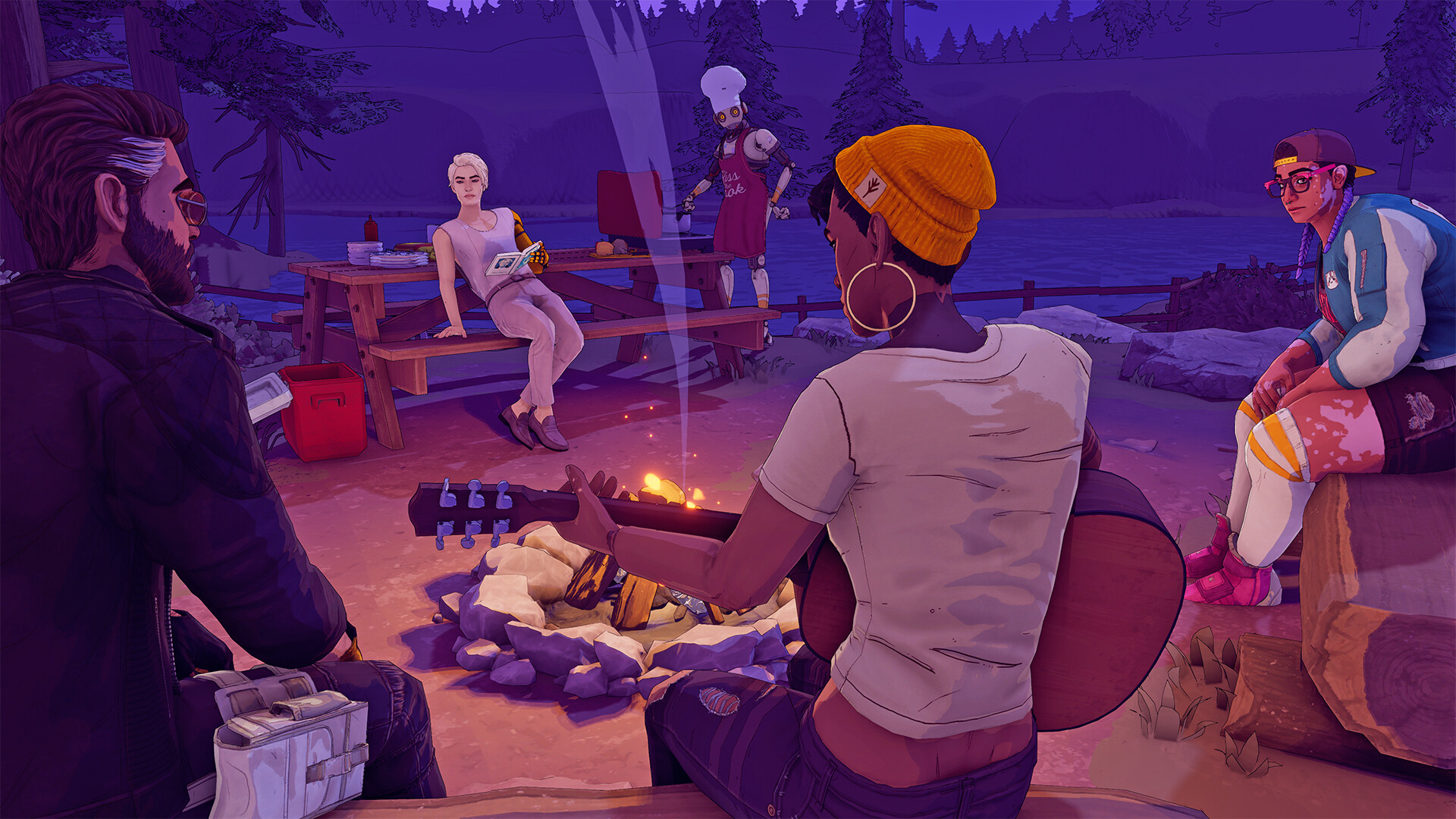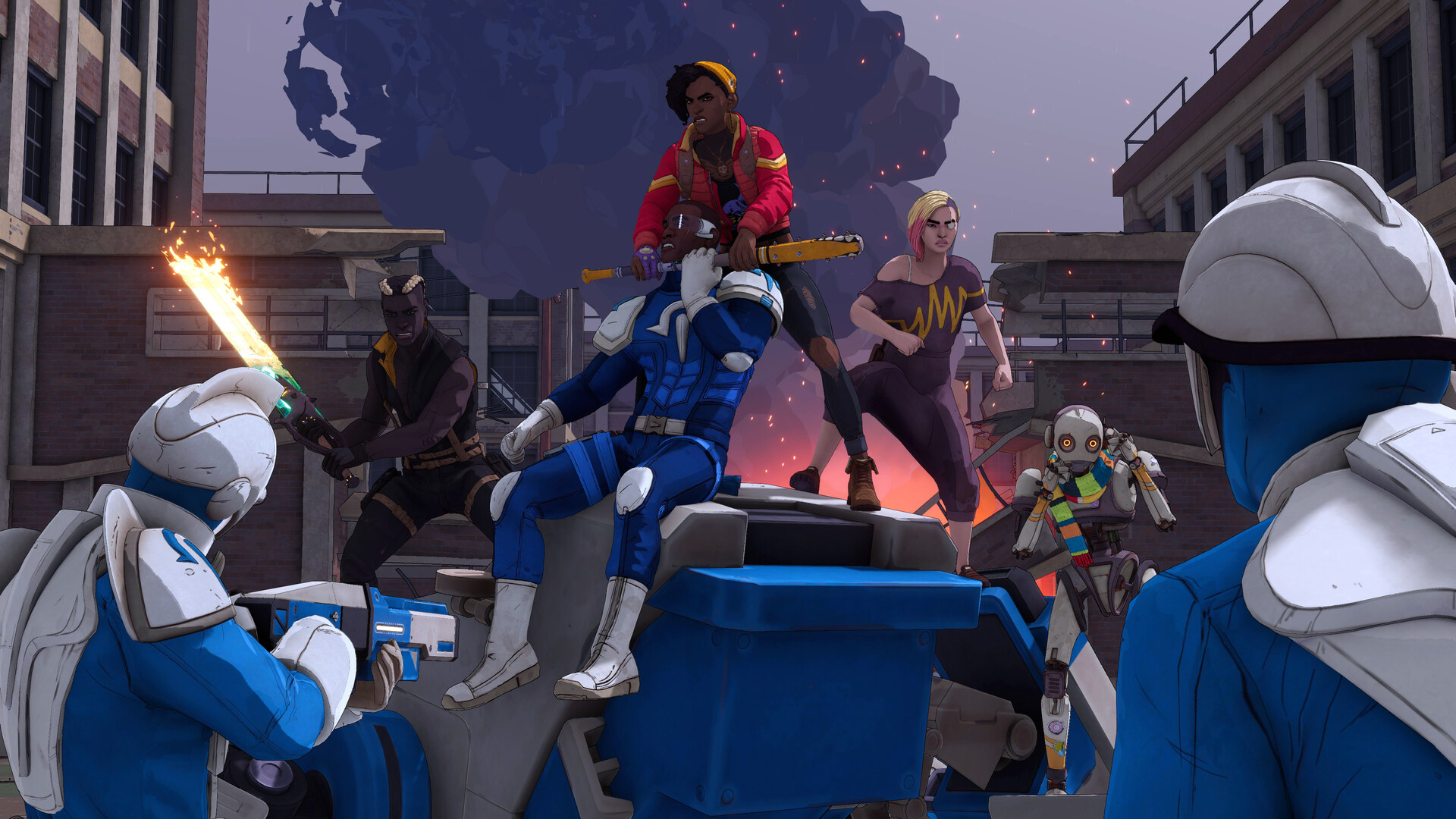A heist (of sorts), a getaway, four unlikely accomplices passively-aggressively at odds on the highway of Pacifica – Red Thread Games’ Dustborn doesn’t exactly start at the shallow end with its world-building and characterization. As Pax, an Anomal who uses words like their weapons, you’re thrust into a tense situation.
Force your friend Sai to stop the car when police sirens start blaring or don’t. Decide how you’ll deal with the officer in question. Opt to trigger them. Watch them get flattened by a passing truck. It’s a notable first impression for an adventure, which would have had more impact if it hadn’t been spoiled in the marketing leading up to launch.
“The plot revolves around a mysterious cargo that Pax and her friends – Sai, Noam, and Theo – must deliver to Nova Scotia, an even more mysterious organization, for unknown reasons.”
This is only the tip of the alternate history American road trip, however. At first glance, it may seem like a cry of rebellion, a push-back against authority with the power of words and the rhythmic button presses of music. It’s also a journey of friends, family, bonding, and acceptance…when it isn’t teasing a background mystery involving a mysterious tree that pops up in Pax’s dreams, perhaps hinting at the origins of her powers. Maybe this is connected to the Voices that also crop up later on. Maybe not.
Dustborn spins several plates throughout its runtime, devoting significant time to its authoritarian world and diverse cast of characters. There’s success on some fronts, stumbling at others, and a roughness that wouldn’t feel out of place among the motley crew, even if it’s more challenging to embrace at times.
The plot revolves around a mysterious cargo that Pax and her friends – Sai, Noam, and Theo – must deliver to Nova Scotia, an even more mysterious organization, for unknown reasons. This is done under the guise of a punk rock band, touring the American Republic and singing not-so-vague songs against oppression. It’s an intriguing set-up that’s far more endearing than the initial heist-gone-wrong would indicate and provides significant time for bonding with your allies. Of course, there’s more to each person’s motivation than meets the eye.
While there’s the promise of a new start for everyone, Pax seeks to reconnect with her estranged family, including her sister, Ziggy. Noam pines for Hong Kong, her homeland, while Sai seeks to become more self-assured. Theo is a wild card – his motives are uncertain despite the dorky dad energy he exudes. However, perhaps the most intriguing thing about each person’s feelings is how Pax’s decisions can influence the side they show her.

“Regardless, the characters are easily the best part of Dustborn’s experience – they’re imperfect, unpredictable, mired in their tribulations and doubts, and yet incredibly endearing.”
For example, Noam could come across as more of an outsider, while Sai becomes better at masking her emotions. Theo, meanwhile, can oscillate between a buddy, father figure, or boss. This approach goes beyond the typical binary of “good vs. evil”, lending more layers to each character and their goals.
While dialogue choices and the like can make some motives more prominent than others, there are also the different Vox that each character (aside from Theo) possesses. For example, Noam can “gaslight” people, calming them and making them more amicable. Sai can turn her skin to stone and also possesses relatively impressive strength.
Aside from Pax’s abilities, which can range from silencing individuals to pushing them back with force, relying on other character’s Vox can affect how your friends view you, for better or worse. Push Sai when she’s emotionally vulnerable, and it may come back to bite you, especially if there are no attempts to smooth things over.
You can’t go against every decision – some situations demand you use Vox. It’s understandable in flashback sequences, especially with some plotlines, but it can feel limiting in certain circumstances. Regardless, the characters are easily the best part of Dustborn’s experience – they’re imperfect, unpredictable, mired in their tribulations and doubts, and yet incredibly endearing, backed by strong voice acting performances.
The systems governing your interactions with them could use some more polish, though. Certain situations will provide new dialogue choices if you wait. If that doesn’t happen, interrupt away, which can sometimes overlap with an ongoing dialogue. It’s especially jarring when you explore the environment and interact with different points of interest, spurring a stream of “so, anyway” among your party as they attempt to continue their trains of thought.

“Unfortunately, Dustborn has bigger issues, especially with performance and optimization. Higher settings resulted in frame drops, even during scenes with very little happening…”
Exploration is otherwise straightforward – objectives are spelt out in large colorful text that fits the overall comic book aesthetic. You can discover items in the environment, some to serve as gifts for your friends and speak to other NPCs for more context on the world. On the punk rock side of things, the rhythm game mechanics are competent – press buttons in time with the beat for a high score and hope your audience is satisfied. However, Pax can also engage in combat, using a bat (an unwitting gift from the Horned Riders.
She can unleash combos, evade, block attacks, and use her Vox to Push foes, with other powers eventually becoming available. You can also taunt an enemy, unleashing a quick damage combo that can wipe out multiple enemies in short order or chunk bosses. Combat is decent, broadly speaking – nothing amazing, really above average, but also more responsive to control than I expected. Following your first battle, options for more or less combat abound, so that’s nice. You can even turn off combat banter (which also suffers from spoken dialogue overriding and conflicting with each other).
Unfortunately, Dustborn has bigger issues, especially with performance and optimization. Higher settings resulted in frame drops, even during scenes with very little happening, including sit-down conversations where you’re casually panning the camera around. Things improved when dialing the quality down, even if performance still felt uneven. It’s not a deal-breaker, but it still occurs enough to impair the experience. There were also cases of background objects disappearing and reappearing.
Fast-forwarding dialogue isn’t possible, which is especially annoying if you decide to start a new playthrough and select different options. The Story So Far feature is good for looking back at the decisions made thus far (and how they compare to other players). However, you can’t view other potential outcomes or hints towards the same in a branching tree a la Quantic Dream’s titles. There’s also no manual saving – quitting out initiates auto save, but certain decisions from a few minutes ago may not have registered, which is more of a nitpick but still worth noting.

“Like any road trip, Dustborn is far from perfect. Nevertheless, it packs enough quirkiness and spontaneity to make it worthwhile while presenting a likeable cast, appealing aesthetic and intriguing premise.”
Overall, I enjoy what Dustborn is going for, warts and all. Red Thread Games opts for an impressive scope with the setting and overall gameplay. As compelling as the former can feel, the latter can feel a bit scattered. The rhythm fan in me vibes with the punk rock approach, while the hack-and-slash enthusiast is indifferent to the combat.
Bonding with the characters and watching them open up, watching the little dialogue boxes hint at potential outcomes of choices, and pressing forward even if I can’t predict their responses is engaging. Going from one part of the environment to another for menial tasks like finding characters or picking up toys is less so.
Like any road trip, Dustborn is far from perfect. Nevertheless, it packs enough quirkiness and spontaneity to make it worthwhile while presenting a likeable cast, appealing aesthetic and intriguing premise.
This game was reviewed on PC.














